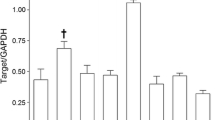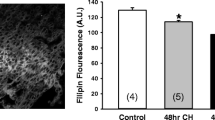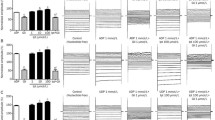Abstract
Flow-induced dilation in resistance arteries is mediated by endothelium-dependent hyperpolarisation via small and intermediate conducting Ca2+ sensitive K+ channels. The aim of the current study was to assess the effect of blocking both channels, using the toxins apamin and charybdotoxin, on flow-induced dilation in a conduit artery and vascular conductance. Experiments were carried out on the iliac and its vascular bed in anaesthetised pigs (n = 4). Flow-induced dilation and vascular conductance (∆F/∆P) were assessed before and after administration of toxins intra-arterially (i.a.) at 50 µg kg−1. Iliac diameter increased from baseline to 2.39 ± 0.4 mm before and 2.09 ± 0.46 mm after toxin administration, which was not significantly different (P = 0.63, Student’s paired t test). Control conductance was 1.49 ± 0.27 ml min−1 mmHg−1 (P < 0.00001, ANOVA), and 1.53 ± 0.18 ml min−1 mmHg−1 (P < 0.00001, ANOVA) in the presence of the toxins which was not significantly different (P = 0.93 homogeneity of regression analysis). There was a small but significant increase in mean arterial pressure after the toxins were administered, from 74 ± 5 to 80 ± 9 mmHg (P = 0.03, Student’s paired t test); but all other measured parameters were not significantly affected. Small- and intermediate-conducting Ca2+-sensitive K+ channels are not involved in flow-mediated dilation in conduit arteries and do not play a role in resistance vessel diameter maintenance at resting blood flow.





Similar content being viewed by others
References
Snow HM, Markos F, O'Regan D, Pollock K (2001) Characteristics of arterial wall shear stress which cause endothelium-dependent vasodilatation in the anaesthetized dog. J Physiol 531:843–848
Garland JG, McPherson GA (1992) Evidence that nitric oxide does not mediate the hyperpolarization and relaxation to acetylcholine in the rat small mesenteric artery. Br J Pharmacol 105(2):429–435
Garland CJ, Dora KA (2017) EDH endothelium-dependent hyperpolarization and microvascular signalling. Acta Physiol 219:152–161
Markos F, Ruane-O'Hora T, Snow HM, Kelly R, Wainwright C, Skene K, Drake-Holland AJ, Noble MI (2008) Dilatation in the femoral vascular bed does not cause retrograde relaxation of the iliac artery in the anaesthetized pig. Acta Physiol 194:207–213
Waldron G, Garland C (1994) Effect of potassium channel blockers on L-NAME insensitive relaxations in rat small mesenteric artery. Can J Physiol Pharmacol 72(suppl. 1):11
Ruane-O'Hora T, Edge D, Shortt CM, Markos F, Noble MI (2013) Responses of iliac conduit artery and hindlimb resistance vessels to luminal hyperfructosemia in the anaesthetized pig. Acta Physiol 209(4):254–261
Gao F, Wang DH (2010) Hypotension induced by activation of the transient receptor potential vanilloid 4 channels: role of Ca2+-activated K+ channels and sensory nerves. J Hypertens 28(1):102–110
Radomski MW, Palmer RM, Moncada S (1987) Comparative pharmacology of endothelium-derived relaxing factor, nitric oxide and prostacyclin in platelets. Br J Pharmacol 92:181–187
Damkjaer M, Nielsen G, Bodendiek S, Staehr M, Gramsbergen JB, de Wit C, Jensen BL, Simonsen U, Bie P, Wulff H, Köhler R (2012) Pharmacological activation of KCa3.1/KCa2.3 channels produces endothelial hyperpolarization and lowers blood pressure in conscious dogs. Br J Pharmacol 165(1):223–234
Acknowledgements
Surgivet Monitor was purchased with a grant from the Strategic Research Fund University College Cork (UCC) 2012. This study was funded by the Dept. Physiology, UCC.
Author information
Authors and Affiliations
Corresponding author
Ethics declarations
Conflict of interest
The authors have no conflict to declare
Additional information
Publisher's Note
Springer Nature remains neutral with regard to jurisdictional claims in published maps and institutional affiliations.
Rights and permissions
About this article
Cite this article
Ruane-O’Hora, T., Markos, F. Small and intermediate Ca2+-sensitive K+ channels do not play a role in vascular conductance during resting blood flow in the anaesthetised pig. Heart Vessels 35, 284–289 (2020). https://doi.org/10.1007/s00380-019-01489-9
Received:
Accepted:
Published:
Issue Date:
DOI: https://doi.org/10.1007/s00380-019-01489-9




